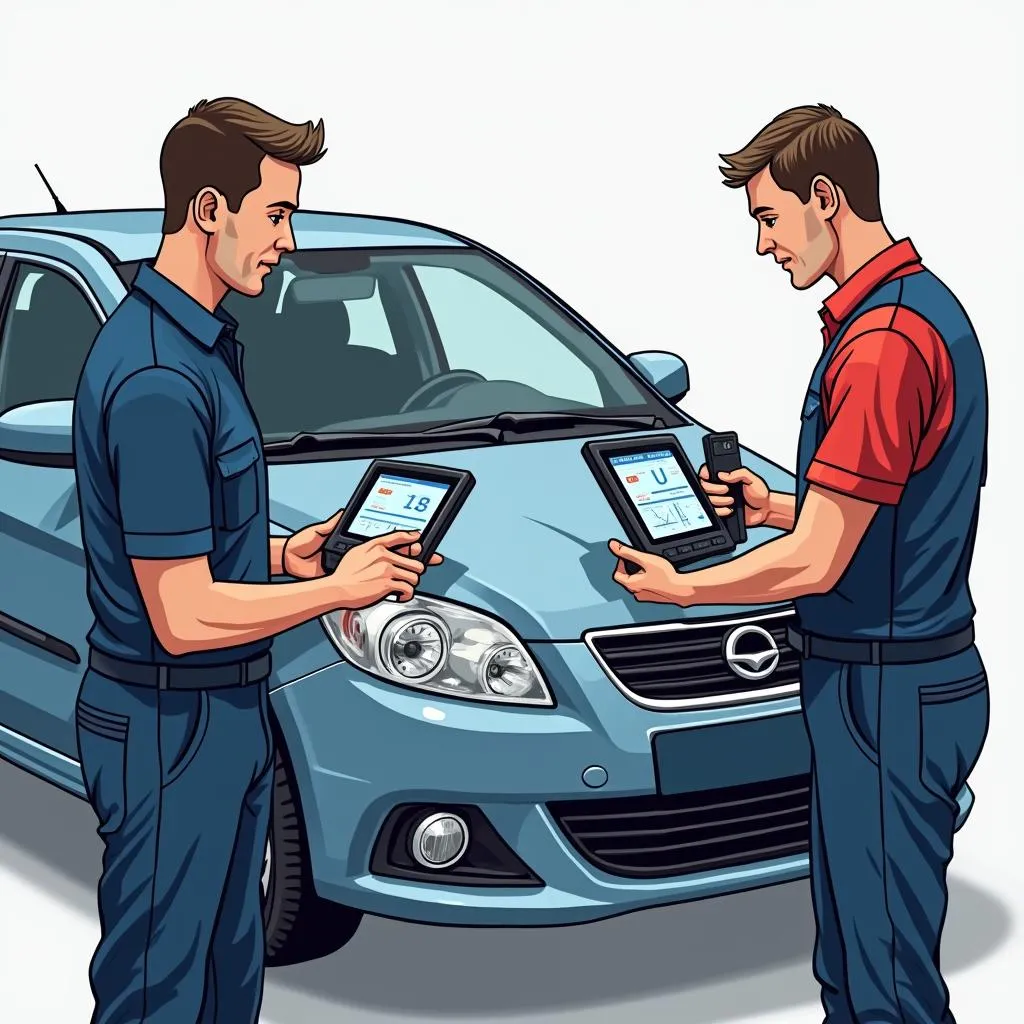Have you ever wished you could connect two scan tools to your European car at the same time? Imagine the possibilities: accessing live data from multiple ECUs, performing simultaneous diagnostics and calibrations, or even comparing readings between different tools for added accuracy. While the idea might seem intriguing, it’s crucial to understand the limitations and potential risks involved before attempting such a feat.
Understanding the Rationale Behind the Question
The question of connecting two scan tools at the same time arises from a desire for efficiency and comprehensive data analysis. Imagine a mechanic working on a complex electrical issue in a Mercedes-Benz C-Class. They need to access data from the engine control unit (ECU), the transmission control module (TCM), and the ABS module simultaneously. This requires connecting multiple scan tools, each capable of communicating with specific ECUs.
However, connecting two scan tools at the same time isn’t as straightforward as it may seem. The complexities of modern automotive networks, the potential for communication conflicts, and the risks of data corruption all play a crucial role in determining whether this practice is feasible and safe.
The Challenges and Risks
Connecting two scan tools simultaneously presents a range of challenges and potential risks:
1. Network Compatibility and Protocol Conflicts:
Modern vehicles employ complex automotive networks like CAN (Controller Area Network), LIN (Local Interconnect Network), and FlexRay. Each network has its own protocols, and not all scan tools are compatible with all protocols. Attempting to connect two incompatible tools can lead to communication conflicts, data errors, and potential damage to the vehicle’s electrical system.
2. Data Integrity and Corruption:
Even if two scan tools are compatible, connecting them simultaneously can lead to data corruption. When multiple tools attempt to communicate with the same ECU, there’s a risk of conflicting commands and data streams, leading to inaccurate readings and potential damage to the ECU’s software.
3. Safety Concerns:
Some manufacturers explicitly warn against connecting multiple scan tools simultaneously. They argue that such actions could interfere with the vehicle’s safety systems, leading to unpredictable behavior and even accidents.
The Practicality and Feasibility
While connecting two scan tools simultaneously might seem appealing, it’s generally not recommended or practical. The potential risks far outweigh the potential benefits in most cases.
Alternatives to Simultaneous Connection:
Instead of connecting two scan tools at the same time, consider these alternative approaches:
- Use a Multi-Protocol Scan Tool:
Invest in a high-quality multi-protocol scan tool capable of communicating with various ECUs and networks. This eliminates the need for multiple tools and minimizes the risk of conflicts.
- Sequential Access:
Use one scan tool to access data from one ECU, then switch to a different tool to access data from a different ECU. This ensures data integrity and minimizes the risk of conflicts.
- Specialized Diagnostic Tools:
For specific tasks like coding or calibration, use specialized tools designed for those functions. These tools are typically optimized for specific ECUs and networks, ensuring compatibility and safety.
Frequently Asked Questions
Q: What are the potential consequences of connecting two scan tools at the same time?
A: The potential consequences range from communication conflicts and data errors to damage to the vehicle’s electrical system and safety risks.
Q: Can I connect two generic scan tools to a European car simultaneously?
A: Connecting two generic scan tools is not recommended as they may not be compatible with the vehicle’s networks and protocols.
Q: Is there a way to safely connect two scan tools to a European car at the same time?
A: While there might be specific scenarios where connecting two scan tools simultaneously is feasible, it’s generally not recommended due to the potential risks.
Q: Are there any specific situations where connecting two scan tools might be necessary?
A: Some advanced diagnostics or calibration tasks might require connecting two specialized tools, but these situations are rare and require expertise.
Our Recommendation
While connecting two scan tools at the same time might seem appealing for faster diagnostics, it’s essential to prioritize safety and data integrity. Invest in high-quality multi-protocol scan tools, follow manufacturer guidelines, and consult with qualified technicians for complex diagnostics. Remember, working with sophisticated electronic systems requires caution and expertise to ensure the safety of your vehicle and yourself.
 Connecting Two Scan Tools at the Same Time for European Cars
Connecting Two Scan Tools at the Same Time for European Cars
For reliable and expert assistance with your European car diagnostics, contact us at Whatsapp: +84767531508. Our team of automotive technicians is available 24/7 to provide support and guidance on all your diagnostic needs.
